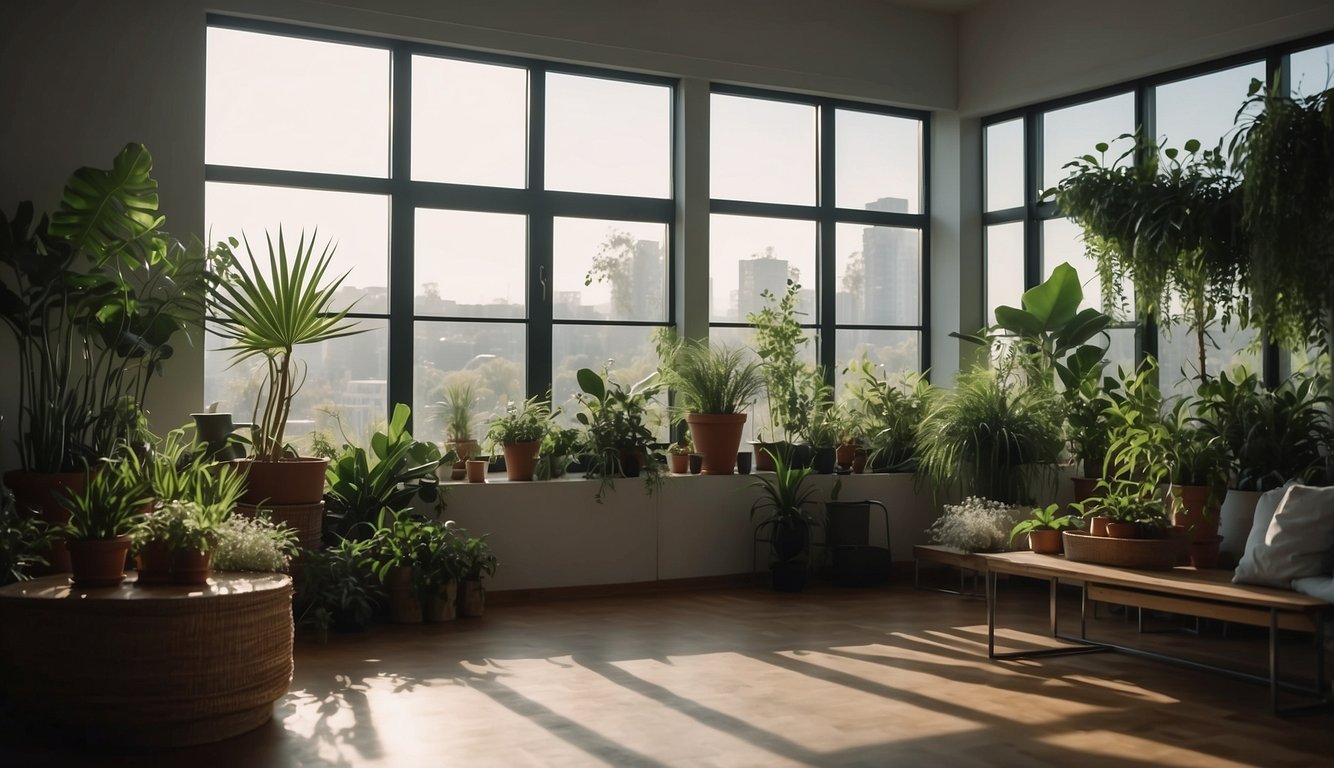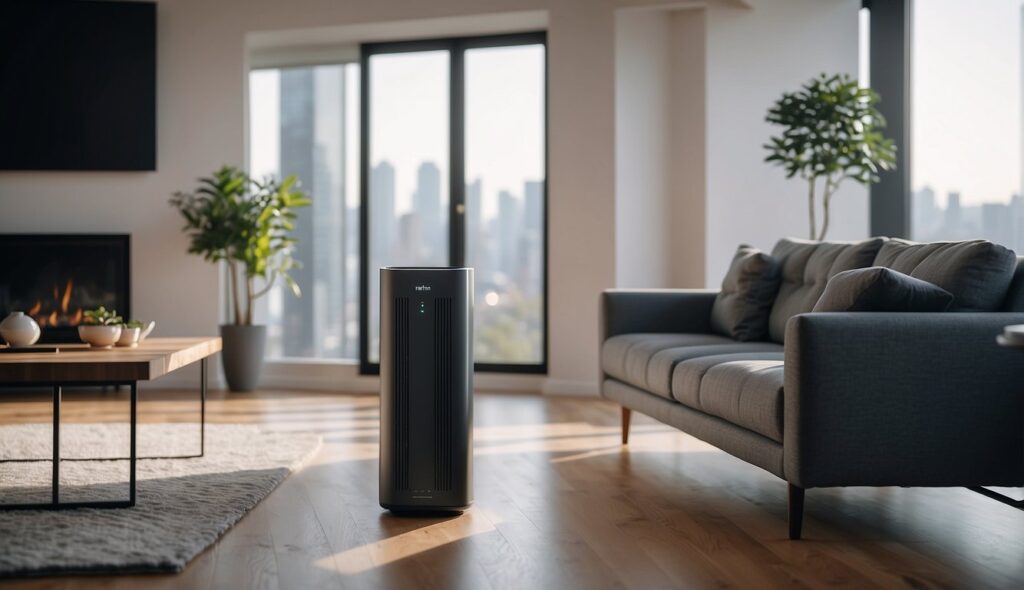Indoor air quality is a critical aspect of our overall health and well-being. With the majority of our time spent indoors, it’s essential to understand the impact of indoor air pollution and the methods available to cleanse the air we breathe. Poor indoor air quality can lead to a range of health issues, from respiratory problems to allergies, making it imperative to explore effective air cleansing methods.

Understanding the sources of indoor pollution is key to addressing air quality concerns. Various factors such as inadequate ventilation, building materials, and household products can contribute to indoor air pollution. Given the significant impact on health, it’s crucial to explore practical and efficient methods to improve indoor air quality and create a healthier living environment.
Table of Contents
Key Takeaways
- Understanding the sources of indoor pollution is crucial for addressing air quality concerns.
- Effective air cleansing methods are essential for improving indoor air quality and creating a healthier living environment.
- Poor indoor air quality can lead to a range of health issues, making it imperative to explore methods for cleansing the air we breathe.
Understanding Indoor Air Quality
As we spend more time indoors, it is essential to understand the quality of the air we breathe. Indoor air quality refers to the air quality within and around buildings and structures. It is a significant concern as it relates to the health and comfort of building occupants.
Indoor air pollutants can come from a variety of sources, including outdoor air, building materials, cleaning products, and activities such as cooking and smoking. Pollutants can be divided into two main categories: particulate matter and gaseous pollutants.
Particulate matter refers to tiny particles suspended in the air, such as dust, pollen, and smoke. These particles can be inhaled and cause respiratory problems. Gaseous pollutants include volatile organic compounds (VOCs) and gases such as carbon monoxide and nitrogen dioxide. VOCs are emitted from products such as paints, adhesives, and cleaning supplies and can cause eye, nose, and throat irritation, headaches, and dizziness.
The most effective way to improve indoor air quality is to remove the sources of pollutants. Proper ventilation is also essential to maintain good air quality. However, in some cases, it may be necessary to use air-cleansing methods to remove pollutants from the air.
Air-cleansing methods include using air purifiers, air filters, and plants. Air purifiers and filters work by trapping particles and pollutants in the air, while plants absorb pollutants through their leaves. It is essential to choose the right air purifier or filter for the specific pollutants you want to remove. For example, HEPA filters are effective at removing particulate matter, while activated carbon filters are better at removing VOCs.
In conclusion, understanding indoor air quality is crucial for maintaining a healthy and comfortable indoor environment. By removing sources of pollutants and using air-cleansing methods, we can improve the quality of the air we breathe.
Sources of Indoor Pollution
When we think of air pollution, we often picture smoggy skies and industrial smokestacks. However, the air inside our homes can be just as polluted as the air outside. In fact, indoor air can be two to five times more polluted than outdoor air. In this section, we will explore some of the most common sources of indoor air pollution.
Household Activities
Many of the activities we do in our homes can contribute to indoor air pollution. For example, cooking can release harmful pollutants such as carbon monoxide, nitrogen dioxide, and particulate matter. Cleaning products can also release harmful chemicals into the air, such as volatile organic compounds (VOCs) and ammonia. Smoking indoors can release a wide range of harmful chemicals into the air, including formaldehyde, benzene, and polycyclic aromatic hydrocarbons (PAHs).
Building Materials
The materials used to build our homes can also contribute to indoor air pollution. For example, asbestos, which was commonly used as insulation until the 1970s, can release harmful fibers into the air when it is disturbed. Formaldehyde, which is used in some types of insulation, can also be released into the air. Lead-based paint, which was commonly used until the 1970s, can also release harmful lead particles into the air when it is disturbed.
Other sources of indoor air pollution can include dust, mold, pollution from outdoor sources such as cars and factories, gas appliances, pesticides, and heating systems. It is important to be aware of these potential sources of indoor air pollution and take steps to reduce them whenever possible.
Health Impacts of Poor Air Quality
As we spend most of our time indoors, indoor air quality is a crucial factor in maintaining good health. Poor indoor air quality can have various health impacts ranging from respiratory diseases to allergies and asthma. According to the American Lung Association, indoor air can be 2-5 times, even up to 100 times, more polluted than outdoor air.
Exposure to poor air quality can cause health symptoms such as irritation of the eyes, nose, and throat, headaches, and dizziness. It can also trigger asthma attacks, especially in people with lung disease and other underlying health conditions. Long-term exposure to indoor air pollutants can lead to chronic respiratory diseases and even premature death.
Indoor air pollution can be caused by various sources such as smoke, vapors, mold, and chemicals used in certain paints, furnishings, and cleaners. According to the World Health Organization, household air pollution was responsible for an estimated 3.2 million deaths per year in 2020, including over 237,000 deaths of children under the age of 5.
Therefore, it is crucial to take steps to improve indoor air quality, such as using air purifiers, regularly cleaning and maintaining HVAC systems, and reducing the use of chemical-based products. By taking these steps, we can reduce the risk of health impacts caused by poor indoor air quality.
Improving Air Quality
When it comes to improving indoor air quality, there are two main methods: filtration systems and ventilation solutions.
Filtration Systems
Air filters are an effective way to remove indoor air pollutants. HEPA filters are the most efficient at capturing small particles, while MERV filters are a more affordable option that can still capture a large percentage of pollutants. It is important to regularly replace air filters to maintain their effectiveness. Furnace filters can also be used to remove pollutants from the air.
Air purifiers are another option for air cleaning. They work by pulling air through a filter, capturing pollutants in the process. Some air purifiers also use UV-C light to kill bacteria and viruses. When choosing an air purifier, it is important to consider the size of the room and the type of pollutants you want to remove.
Ventilation Solutions
Proper ventilation is crucial for maintaining good indoor air quality. HVAC systems can be equipped with filters to remove pollutants from the air. It is important to regularly clean and maintain HVAC systems to ensure their effectiveness.
Opening windows and doors is a simple and effective way to increase air exchange and improve indoor air quality. It is recommended to open windows for at least 5-10 minutes a day to allow fresh air in.
In addition to opening windows, using fans can also help improve air circulation and reduce indoor air pollutants. It is important to ensure that bathrooms and other potential sources of mold are well ventilated as well.
Overall, improving indoor air quality requires a combination of source control, air cleaning, and proper ventilation. By using filtration systems and ventilation solutions, we can reduce the amount of indoor air pollutants and improve the overall health of our indoor environment.
Conclusion

In conclusion, the quality of indoor air is crucial to our health, whether we are at home, work, or school. Poor air quality can lead to various health effects, including respiratory problems, allergies, and even cancer. Therefore, it is essential to take measures to ensure that the air we breathe indoors is clean and healthy.
There are various methods available for cleansing indoor air, including air purifiers, ventilation systems, and cleaning technologies. Each method has its advantages and disadvantages, and the choice of method will depend on the specific needs of the individual.
We recommend using a combination of methods to achieve the best results. For example, using an air purifier with a HEPA filter can help remove pollutants from the air, while a ventilation system can bring in fresh air and remove stale air. Additionally, regular cleaning and maintenance of HVAC systems, ducts, and filters can help reduce the amount of dust and other contaminants in the air.
It is also important to be aware of the sources of indoor air pollution and take steps to reduce or eliminate them. This can include using natural cleaning products, avoiding smoking indoors, and properly storing chemicals and other hazardous materials.
Overall, by taking a proactive approach to indoor air quality, we can create a healthier and more comfortable environment for ourselves and our loved ones.
Frequently Asked Questions
What are the most effective natural methods for purifying indoor air?
Plants are the most effective natural method for purifying indoor air. They absorb carbon dioxide and release oxygen while also removing toxins such as formaldehyde, benzene, and trichloroethylene from the air. Some of the best plants for air purification include spider plants, peace lilies, and Boston ferns.
How can I reduce indoor air pollution in my home?
There are several ways to reduce indoor air pollution in your home. First, make sure to regularly clean and vacuum your home to remove dust and other particles. You can also use natural cleaning products instead of harsh chemicals. Additionally, you can improve ventilation in your home by opening windows and using exhaust fans in bathrooms and kitchens.
What are the benefits of using an air purifier in the home?
Air purifiers can help remove pollutants such as dust, pollen, and pet dander from the air in your home. This can be especially helpful for those with allergies or respiratory issues. Additionally, air purifiers can help remove odors from the air, making your home smell fresher.
What strategies can I employ to keep the air in my home clean without using an air purifier?
In addition to regular cleaning and ventilation, you can also use natural air fresheners such as essential oils or baking soda. You can also invest in high-quality air filters for your HVAC system to help remove pollutants from the air.
What are the quickest techniques to improve indoor air quality?
The quickest technique to improve indoor air quality is to open windows and doors to improve ventilation. You can also use natural air fresheners such as essential oils or baking soda to help remove odors from the air.
How can I ensure that the air purification method I choose is safe and effective?
When choosing an air purification method, make sure to do your research and choose a method that is safe and effective. Look for products that have been certified by reputable organizations such as the Environmental Protection Agency (EPA) or the American Lung Association. Additionally, make sure to follow all instructions carefully to ensure safe and effective use of the product.


